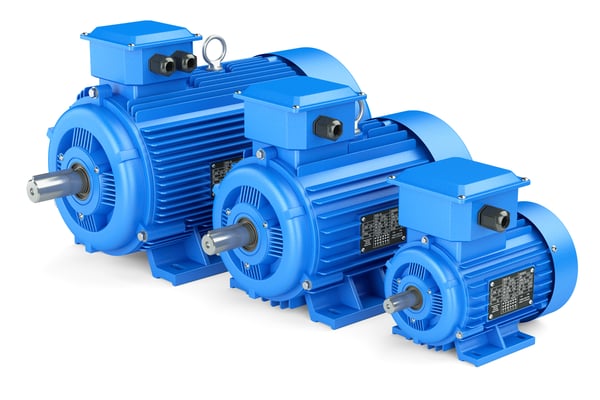Energy Efficiency Upgrades: High-Efficiency Motors with Speed Controls

Electric motors are normally hidden from sight, but they are used by many types of equipment. In all types of buildings, plumbing and mechanical systems are strongly dependent on motors. They can be found in pumps, fans, air conditioning compressors and chillers, to name a few examples. Given their widespread use, motors consume over 40% of the world’s electricity.
Building owners can reduce power bills significantly by improving motor efficiency. There are two main ways to achieve this, which can be combined for better results:
- Replacing old and inefficient motors with more modern units.
- Controlling the speed of motors according to their workload.
An adequate power supply is fundamental for electric motors. If a motor is exposed to frequent voltage fluctuations, its service life is reduced dramatically. Before upgrading your motors and adding speed controls, check if your power supply has a stable voltage and frequency.
Improve your building's energy efficiency with an electric motor upgrade.
Upgrading to High-Efficiency Motors
When upgrading the motors in a building, the best recommendation is looking for units with recognized efficiency ratings. The National Electrical Manufacturers Association (NEMA) is the industry authority in North America, setting standards for many categories of electrical equipment. In the case of motors, NEMA Premium is the highest efficiency rating available as of September 2019.
Motors that are manufactured outside of the US follow standards from the International Electrotechnical Commission (IEC). The highest efficiency level for IEC motors as of September 2019 is the IE4 Super Premium Efficiency. An even higher efficiency rating is being developed, which will offer 20% savings with respect to IE4: the IE5 Ultra Premium Efficiency.

Another important factor is purchasing the right horsepower. Electric motors can operate near rated efficiency at various loading conditions. However, they experience a drastic loss of efficiency when their load drops to around 50%. An oversized motor also comes with a higher price tag and increased maintenance costs.
How Controlling Motor Speed Increases Efficiency
Many electric motors are subject to variable loading conditions, which means their rated horsepower is not used all the time.
- Motors are often left running at full power when not necessary, wasting power and potentially causing performance issues. For example, this results in excessive pressure in pumping systems, and overventilation in air handlers.
- A simple control solution is using the motor intermittently, but this can have a negative effect in some cases. For instance, if a building area needs continuous ventilation, the air handler cannot run intermittently.
Adjusting the speed of a motor according to its workload is a much better solution. The motor can operate continuously, while consuming less energy than an intermittent motor. For example, a motor at 70% speed consumes less energy that an identical motor running 70% of the time. The best method to control motor speed depends on its size:
- For motors above 1 hp, electrical engineers normally recommend a variable frequency drive, or VFD. This device lowers the voltage and frequency below rated values, to reduce shaft speed (rpm).
- For applications below 1 hp with variable workload, the best recommendation is an electronically commutated motor, also known as a brushless DC motor. These have built-in speed controls, and they don’t require VFDs.
Note that some equipment comes with factory-installed motors, and warranties may be voided by an incorrect replacement. In these cases, you should look for compatible motors that are labeled as OEM, which stands for “original equipment manufacturer”. If you plan to upgrade a piece of equipment completely instead of just a motor, ask the vendor for the most efficient motor that can be factory-installed in the new unit.
Conclusion
When upgrading motors, the shortest payback period is normally achieved with motors that have a long operating schedule. Speed controls in particular have the best effect when motors operate at partial load for extended periods.
Consider that HVAC systems represent the largest share of consumption in most residential and commercial buildings. Since electric motor upgrades can improve HVAC efficiency, the potential savings are significant. High-efficiency motors with speed controls can also save plenty of energy when used in pumping systems.

Michael Tobias
Michael Tobias, the Founding Principal of NY Engineers, currently leads a team of 150+ MEP/FP engineers and has led over 4,000 projects in the US
Join 15,000+ Fellow Architects and Contractors
Get expert engineering tips straight to your inbox. Subscribe to the NY Engineers Blog below.

